How to Play Yu-Gi-Oh!: Spells, Traps and Effects in Depth
Welcome back to our discussion of Yu-Gi-Oh! rules. In this installment, we shall be taking a closer look at the various types of Spell and Trap cards, and how effects can differ. We shall also have a look at the mechanic of ‘Spell Speeds’, which explains how cards can respond to each others’ effects!
Symbol Key
As has been mentioned previously, Spell and Trap cards have different sub-types, which can be recognised by a visual shorthand:
![]() – Continuous Spell and Trap cards are represented by this infinity symbol. They stay face-up on the field after they activate, but they need to be on the field to use their effect. If they’re destroyed at any point, their effect vanishes!
– Continuous Spell and Trap cards are represented by this infinity symbol. They stay face-up on the field after they activate, but they need to be on the field to use their effect. If they’re destroyed at any point, their effect vanishes!
![]() – The compass represents Field Spell cards. These have their own special area and can apply to both players at once, depending on the card’s effect. Both players may control one field spell – attempting to play another, even setting it, overrides the previous and sends it to the graveyard! These stay on the field until destroyed or replaced.
– The compass represents Field Spell cards. These have their own special area and can apply to both players at once, depending on the card’s effect. Both players may control one field spell – attempting to play another, even setting it, overrides the previous and sends it to the graveyard! These stay on the field until destroyed or replaced.
![]() – Equip cards stay on the field after their activation, but are linked to a single monster! When you activate the card, you choose a face-up monster on the field, and the equip card modifies that monster (and only that monster). If the monster leaves the field, the equip card does too, and if the monster s turned face-down by any means, the equip card also goes to the graveyard. Destroying the equip card does no harm to the monster unless the card specifies otherwise.
– Equip cards stay on the field after their activation, but are linked to a single monster! When you activate the card, you choose a face-up monster on the field, and the equip card modifies that monster (and only that monster). If the monster leaves the field, the equip card does too, and if the monster s turned face-down by any means, the equip card also goes to the graveyard. Destroying the equip card does no harm to the monster unless the card specifies otherwise.
![]() – This symbol denotes that the card is a Ritual Spell card. These are used in a special type of Summoning, called Ritual Summoning. For this to be done, the player needs to have the specified Ritual Monster in their hand, and be able to offer monsters as tribute from either their hand or field. When this is done, the Ritual Monster is summoned!
– This symbol denotes that the card is a Ritual Spell card. These are used in a special type of Summoning, called Ritual Summoning. For this to be done, the player needs to have the specified Ritual Monster in their hand, and be able to offer monsters as tribute from either their hand or field. When this is done, the Ritual Monster is summoned!
![]() – Quick Play Spell cards are a sort of hybrid between Spell and Trap cards. During your turn, they can be activated from hand at any time, but they can also be used on your opponent’s turn if they are set. This makes Quick Play cards very flexible, as they can serve as ‘Traps’ on the opponent’s turn.
– Quick Play Spell cards are a sort of hybrid between Spell and Trap cards. During your turn, they can be activated from hand at any time, but they can also be used on your opponent’s turn if they are set. This makes Quick Play cards very flexible, as they can serve as ‘Traps’ on the opponent’s turn.
![]() – Counter traps are unique in the fact that only other Counter Traps can be activated in response to them. This makes them potentially the most powerful type of card in the game, in as much as only a few cards can stop their activation!
– Counter traps are unique in the fact that only other Counter Traps can be activated in response to them. This makes them potentially the most powerful type of card in the game, in as much as only a few cards can stop their activation!
Spell Speeds and Chains
Yu-Gi-Oh is a game where all effects are interactive – you have the chance to counter your opponent’s moves through activating cards of your own! When a player activates an effect, the opponent is given the chance to respond to it before it activates; after that, the original player can respond to that! If a player chooses not to activate an effect in response to another, the other player has the right to chain to their own effect. This is similar to the ‘stack’ in other games. Effects wait their turn to be activated, with the most recently activated card resolving first.
This is easier to see in an example:
Player 1 Normal Summons Gemini Elf. At this point, Player 2 has the option to respond, and chooses to activate their Trap Hole, which would destroy Gemini Elf. Player 1 can choose to use their own effect at this time, and activates Forbidden Lance, targeting Gemini Elf. Neither Player 1 nor Player 2 activate any further effects at this time.
It is easiest to imagine resolving the chain as making a pile of cards face up. As cards are activated, they are placed on top of the card they respond to, and the topmost card is resolved first. So, first we should resolve Forbidden Lance, which makes Gemini Elf immune to other Spell and Trap cards. This is resolved before the Trap Hole, so Gemini Elf is not destroyed by Trap Hole’s effect! Trap Hole still resolves, but Gemini Elf is simply impervious to its effect.
So, chains resolve in the reverse order to their activation. However, there is a little bit more to chains than this! Spell Speed is an important piece of information, which dictates which effects can be used at a given time. These are:
- Spell Speed 1 effects are the ‘slowest’ effects in the game. These include Normal, Ritual, Equip, Continuous and Field Spell cards, along with many monster effects. These cannot be activated in response to any effects, even themselves.
- Spell Speed 2 effects are faster. They include Normal and Continuous Traps, Quick-Play Spells, along with certain monster effects (which usually include the phrase ‘during either player’s turn, or are described as ‘quick effects’). These effects can be used in response to Spell Speed 1 and 2 effects, and follow normal chain rules.
- Spell Speed 3 effects are the fastest in the game. Only Counter Traps have this speed, and they can be activated in response to all three Spell Speeds. Only Counter Traps can respond to other Counter Traps, which means that these usually denote the end of a chain!
Chains might sound complicated, but in practice, they make a lot of sense!
Costs and Effects
Yu-Gi-Oh cards often have a cost for their effect, which the ‘Problem Solving Card Text’ of later sets makes easy to recognise.
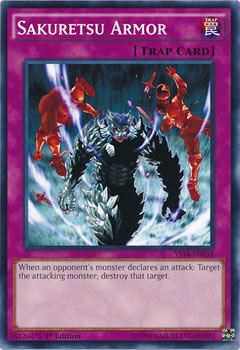
Sakuretsu Armor displays all three clauses that can be on a card – ‘activation timing’, ‘cost and activation’ and ‘effect’.
The first is easy to note, as it tells you when to use the card! ‘When an opponent’s monster declares an attack:’. Please note that this comes before the colon, which tells you that this is the activation timing!
The ‘cost and activation’ clause is what you need to do when you activate the effect. You immediately do what the card tells you to do at this time (which can be paying life points, targeting a monster or so forth) before the chain proceeds. This is important because many cards can be used to destroy one specific monster, and it’s only polite to tell your opponent which one you’re trying to destroy! Many cards do not have costs or actions to perform at activation, but those that do use a semi-colon to show you that this occurs on activation. In this case, this is shown by ‘target the attacking monster;’.
The final clause on a card is the effect. This is what the card actually does, and Spell, Trap and Effect monsters always have this clause! Cards with effects may have any combination of the three clauses, but always include the ‘effect’ clause. If a card’s effect is ‘negated’, it is only this part of the card which is cancelled.

Bottomless Trap Hole is an example of a card with only an ‘activation timing’ and an ‘effect’ clause. When your opponent summons a monster, you can activate it, then normal chain rules apply. Nothing then needs to happen until the effect is resolved! This means that the card has no cost, which is very important.
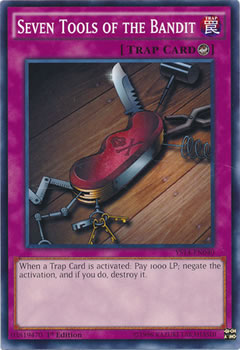 But what is a cost? Costs are actions performed when a card is activated, and are completely separate to their effects. Seven Tools of the Bandit is a perfect card to examine when learning costs! If we break the card down into its three clauses, we have the activation timing of ‘when a Trap Card is activated:’, the activation cost of ‘Pay 1000 LP;’ and the effect ‘negate the activation, and if you do, destroy it.’ Costs have to be paid when the card is activated, or the card cannot be activated at all. Seven Tools of the Bandit, therefore, cannot be used when the player is on 1000 LP or below, as they cannot pay the cost without losing the game! Further, costs are not part of effects. If Seven Tools of the Bandit were used to negate the activation of another Seven Tools of the Bandit, that player would not regain 1000 life points. When a cost is paid, it is not refundable even if your card ends up doing nothing. Costs therefore differ hugely from effects.
But what is a cost? Costs are actions performed when a card is activated, and are completely separate to their effects. Seven Tools of the Bandit is a perfect card to examine when learning costs! If we break the card down into its three clauses, we have the activation timing of ‘when a Trap Card is activated:’, the activation cost of ‘Pay 1000 LP;’ and the effect ‘negate the activation, and if you do, destroy it.’ Costs have to be paid when the card is activated, or the card cannot be activated at all. Seven Tools of the Bandit, therefore, cannot be used when the player is on 1000 LP or below, as they cannot pay the cost without losing the game! Further, costs are not part of effects. If Seven Tools of the Bandit were used to negate the activation of another Seven Tools of the Bandit, that player would not regain 1000 life points. When a cost is paid, it is not refundable even if your card ends up doing nothing. Costs therefore differ hugely from effects. 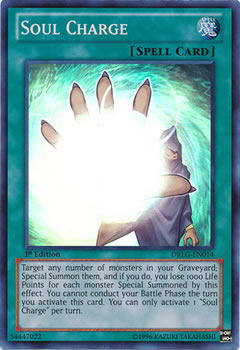
Soul Charge, for example, is a card which has an ‘on-activation’ clause, but no cost. If the card’s effect resolves, the player loses life points depending on the monsters summoned, but this is certainly in the ‘effect clause’!
Negating the effect this card, therefore, would mean that the player does not get to Special Summon any monsters, but equally does not lose any life points. Thanks to Problem Solving Card Text, it is therefore unambiguous which parts of a card mean what. Activation timing is before a colon, activation and costs are before a semi-colon, while effects are only before a full stop.
Missing the Timing
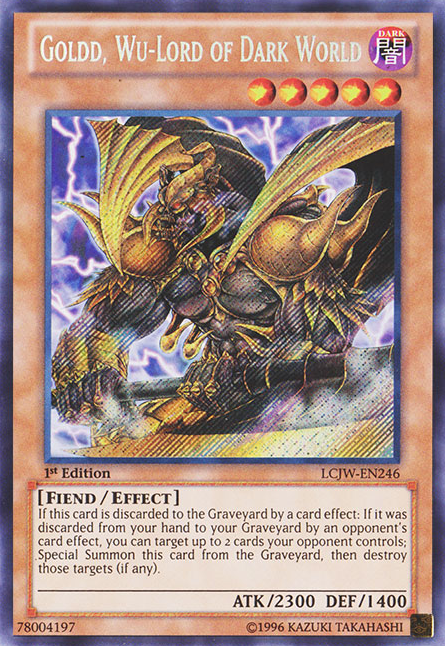 The difference between costs and effects can also govern how other cards are used. For example, Goldd, Wu-Lord of Dark World (pictured left) may only use his effect when discarded by a card effect, whereas a card such as Fabled Kruz (pictured below) may use her ability whenever she’s discarded. Recent errata have made this distinction much easier to spot, but previously the cards had to be understood by the rather specific differences between their various ‘activation timings’! This is potentially the most complicated thing in Yu-Gi-Oh to understand, and it is a concept called ‘Missing the Timing’.
The difference between costs and effects can also govern how other cards are used. For example, Goldd, Wu-Lord of Dark World (pictured left) may only use his effect when discarded by a card effect, whereas a card such as Fabled Kruz (pictured below) may use her ability whenever she’s discarded. Recent errata have made this distinction much easier to spot, but previously the cards had to be understood by the rather specific differences between their various ‘activation timings’! This is potentially the most complicated thing in Yu-Gi-Oh to understand, and it is a concept called ‘Missing the Timing’.
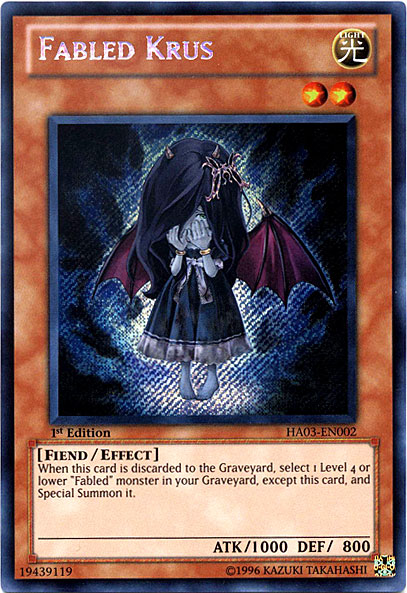
Depending on the wording (especially on older cards), an effect might not get to activate. This is because some cards have optional effects and some have compulsory effects. A card with the effect ‘When x happens… do y’ (such as Fabled Kruz), cannot miss the timing. This is because her effect is compulsory, so you have no choice but to activate the ability! Optional effects are different, and have two different forms. One is ‘If x… you can do y’ and the other is ‘When x happens… you can do y’.
‘If x happens… you can do y’ is an example of an optional effect that does not miss the timing. This is because it only checks if an event has happened, and then you get to have the choice of whether to use the effect. This means that the effect can activate even if used as part of a cost!
 ‘When x happens… you can do y’ is an example of an optional effect which does miss the timing. This is because ‘x’ has to be the last event which happened before an effect can resolve. Peten the Dark Clown is an example of a card with this effect wording. Peten cannot activate his effect if sacrificed for a Tribute Summon, for example, as the last thing which occurred was a monster being summoned! If these cards are used as a cost, their effects will miss the timing, meaning that they cannot be used. If you manage to understand these crucial differences, then you have learned the most complicated rule in Yu-Gi-Oh!
‘When x happens… you can do y’ is an example of an optional effect which does miss the timing. This is because ‘x’ has to be the last event which happened before an effect can resolve. Peten the Dark Clown is an example of a card with this effect wording. Peten cannot activate his effect if sacrificed for a Tribute Summon, for example, as the last thing which occurred was a monster being summoned! If these cards are used as a cost, their effects will miss the timing, meaning that they cannot be used. If you manage to understand these crucial differences, then you have learned the most complicated rule in Yu-Gi-Oh!
Missing the Target
 There is, however, one similar note to ‘missing the timing’, which is ‘missing the target’. Some effects, such as Bottomless Trap Hole, require the card to which they respond to be in a certain state. For example, Bottomless Trap Hole is activated when a monster is summoned with 1500 or more Attack, but the effect is ‘destroy that monster(s) with 1500 or more Attack’. This means that, if a card is activated in response to Bottomless Trap Hole which lowers that monster’s Attack, Bottomless Trap Hole cannot destroy the monster! It is always worth being on the lookout for these sort of effects; for example, the powerful card Mirror Force reads ‘When your opponent’s monster declares an attack: Destroy all Attack position monsters your opponent controls’. This means that if you activate a card to change your monster’s battle position to defence mode, it cannot be destroyed by Mirror Force! Similarly, turning a monster face-down will stop Bottomless Trap Hole from destroying it, as, when the card resolves, the monster’s Attack is unknown. It is important to know what cards can miss the target, as it can allow you to save your monsters and win games!
There is, however, one similar note to ‘missing the timing’, which is ‘missing the target’. Some effects, such as Bottomless Trap Hole, require the card to which they respond to be in a certain state. For example, Bottomless Trap Hole is activated when a monster is summoned with 1500 or more Attack, but the effect is ‘destroy that monster(s) with 1500 or more Attack’. This means that, if a card is activated in response to Bottomless Trap Hole which lowers that monster’s Attack, Bottomless Trap Hole cannot destroy the monster! It is always worth being on the lookout for these sort of effects; for example, the powerful card Mirror Force reads ‘When your opponent’s monster declares an attack: Destroy all Attack position monsters your opponent controls’. This means that if you activate a card to change your monster’s battle position to defence mode, it cannot be destroyed by Mirror Force! Similarly, turning a monster face-down will stop Bottomless Trap Hole from destroying it, as, when the card resolves, the monster’s Attack is unknown. It is important to know what cards can miss the target, as it can allow you to save your monsters and win games!
Conclusion
In this instalment, we have learned what the various types of Spell and Trap cards can do; Spell Speeds and Chains; the difference between activation timing, activation, costs and effects; the difference between compulsory and optional effect wordings and how missing the target works. In our next instalment, we will be looking at the various different types of Special Summoning!
Yu-Gi-Oh! singles are available to purchase at Big Orbit Cards: Yu-Gi-Oh!

Pingback:How to Play Yu-Gi-Oh!: The Absolute Basics | Big Orbit Games